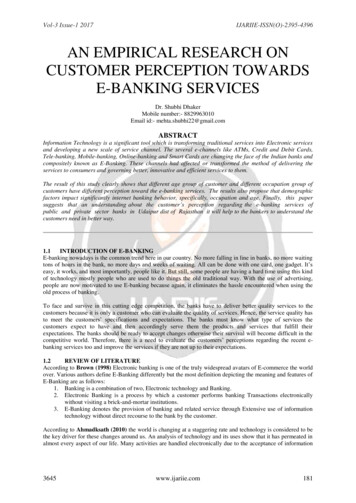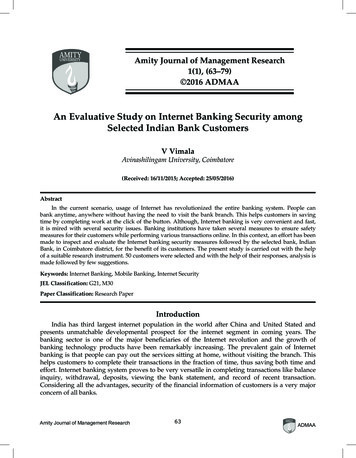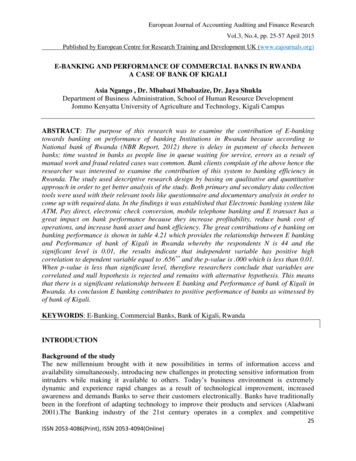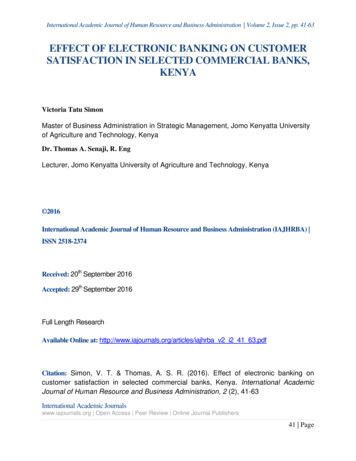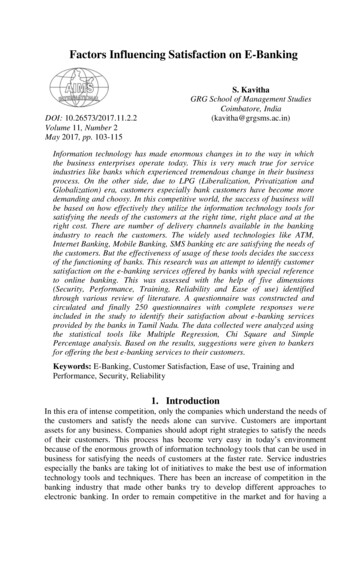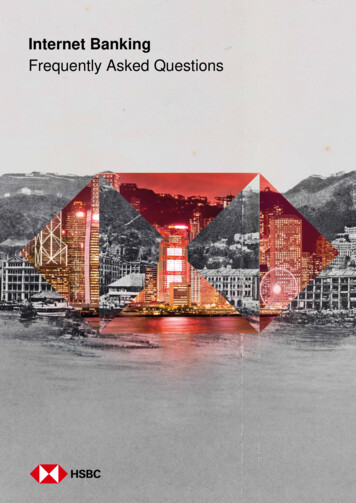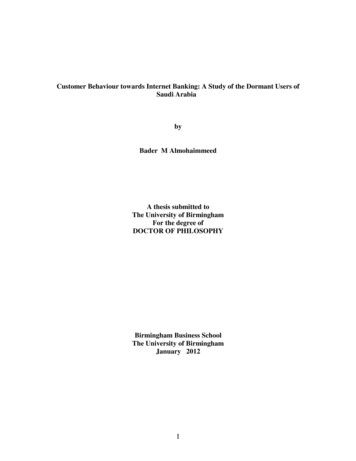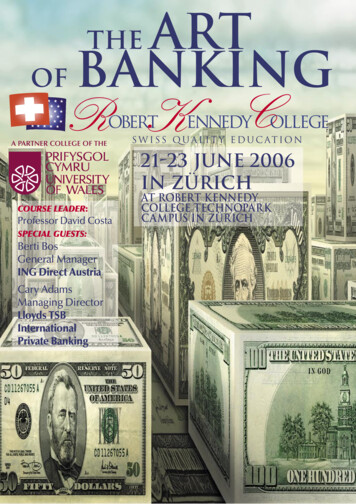
Transcription
International Journal of Computing & Business ResearchISSN (Online): 2229-6166Customer perception towards Internet bankingw.r.f to private and foreign banks in IndiaEr. Vishal Mohan Goyal & Mrs. Gania GoyalAsst. Professor, Department of Computer Applications,Lala Lajpat Rai Institute of Engineering & Technology,MogaAbstractBanking is a highly information intensive activity that relies heavily on information technology (IT) to acquire,process, and deliver the information to all relevant customers. Banks used the Internet technology as a strategicweapon to revolutionize the way they operate, deliver, and compete against each other. As a result OnlineBanking was introduced as a channel where bank customers could perform their financial transactionselectronically via their banks’ Web sites. In this study an analysis of the differences in risk perceptions betweenbank customers using Internet Banking and those not using Internet Banking was done and it showed that riskperceptions in terms of financial, psychological and safety risks among customer not using the internet wasmore meaningful than those using internet banking. Customers not preferring to use internet banking thoughtthat they would be swindled when using this service, and therefore, are particularly careful about high riskexpectation during money transfers from and between accounts. Private and foreign banks are trying to turnmore and more customer towards the usage of internet for the banking transaction. This study is basically toknow the relation of various independent variables on the customer usage of internet for banking.Key words: Internet banking, online, Bank, perception, e-banking.IntroductionNeed for internet banking: One has to approach the branch in person, to withdraw cash ordeposit a cheque or request a statement of accounts. In true Internet banking, any inquiry ortransaction is processed online without any reference to the branch (anywhere banking) atany time. Providing Internet banking is increasingly becoming a "need to have" than a "niceto have" service. The net banking, thus, now is more of a norm rather than an exception inmany developed countries due to the fact that it is the cheapest way of providing bankingservices.Why this research: An analysis of the differences in risk perceptions between bankcustomers using Internet Banking and those not using Internet Banking was done and itshowed that risk perceptions in terms of financial, psychological and safety risks amongcustomer not using the internet was more meaningful than those using internet banking.Customers not preferring to use internet banking thought that they would be swindled whenusing this service, and therefore, are particularly careful about high risk expectation duringmoney transfers from and between accounts. Only 37% of Indian Internet users come fromTop 10 cities i.e. Mumbai, Bangalore, Delhi, Calcutta, Chennai, Pune, Hyderabad,Ahmedabad, Surat and Nagpur. Another day and another number. As per IAMAI and I-cube,the number of active Internet user (i.e. ones who logon to Internet atleast once a month) isnow 32 million and numbers who have used Internet at least once stands at 46 million.Proceedings of ‘I-Society 2012’ at GKU, Talwandi Sabo Bathinda (Punjab)
International Journal of Computing & Business ResearchISSN (Online): 2229-6166Maximum of the person who are going on for internet banking lies in the age bracket of 2635. But the rises in the age the level of users become low. Approximately 17% of female useinternet banking. This is a matter of concern for banks what are the causes why this ishappening.Although many major banks have started offering i-banking services, the slow pace willcontinue until the critical mass is achieved for PC, internet connections and telephones.However, the upsurge of IT professionals with growing demands is pressuring thegovernment and bureaucracy in the country to support and develop new initiatives for a fasterspread of i-banking. But then to there is a fear in mind of customer using internet as amedium for the banking transaction.This study is basically to know the relation of various independent variables on the customerusage of internet for banking.OBJECTIVE OF THE STUDY Perceptual mapping of internet banking users. To know the cause why customers are not using internet banking To know which age group of customers is using different e-banking facilitiesLITERATURE REVIEW[1] Joseph et al. (1999) investigated the influence of internet on the delivery of bankingservices. They found six underlying dimensions of e-banking service quality such asconvenience and accuracy, feedback and complaint management, efficiency, queuemanagement, accessibility and customization. Jun and Cai (2001) identified 17 servicequality dimensions of i-banking service quality. These are reliability, responsiveness,competence, courtesy, credibility, access, communication, understanding the customer,collaboration, continuous improvement, content, accuracy, ease of use, timeliness, aesthetics,security and divers features. They also suggested that some dimensions such asresponsiveness, reliability and access are critical for both traditional and internet banks.Jayawardhena (2004) transforms the original SERVQUAL scale to the internet context anddevelops a battery of 21 items to assess service quality in e-banking. By means of anExploratory Factor Analysis (EFA) and a Confirmatory Factor Analysis (CFA), these 21Proceedings of ‘I-Society 2012’ at GKU, Talwandi Sabo Bathinda (Punjab)
International Journal of Computing & Business ResearchISSN (Online): 2229-6166items are condensed to five quality dimensions: access, website interface, trust, attention andcredibility.[2] IAMAI report on online banking 2006. 43% of online banking user haven’t startedonline financial transaction because of security reasons, 39% haven’t started because theyprefer face to face, 22% haven’t started because they don’t know how to use, for 10% sitesare not user friendly and for 2% banks are not providing the facility of internet banking.According to research 68% of the customers can not say that when they will be starting thefinancial transactions through internet. Maximum numbers of online banking users are maleand maximum of them are in age the group of 25-35. Numbers of female users are very lessi.e. 17% only. More than 60% of the people who are having account with have accounts in 34 banks.[3] Meuter et al. (2000) have identified critical incidents of customer satisfaction anddissatisfaction with technology-based service encounters. Given that business-to-businesstransactions are the fastest growing segment of technology-driven services (Hof, 1999);Meuter and his colleagues (2000) suggested investigating what drives business customersatisfaction or dissatisfaction with technologydriven services. According to Gönroos (1982),customers distinguish the quality of customer interactions that take place during servicedelivery (functional quality) and the quality of the outcome the customer receives in theservice encounter (technical quality).[4] The Indian Internet Banking Journey In 2001, a Reserve Bank of India survey revealedthat of 46 major banks operating in India, around 50% were either offering Internet bankingservices at various levels or planned to in the near future. According to a research report,(India Research, Kotak Securities, May 2000.) while in 2001, India's Internet user base was anestimated 9 lakh; it was expected to reach 90 lakh by 2003. Also, while only 1% of theseInternet users utilized the Internet banking services in 1998, the Internet banking user baseincreased to 16.7% by mid- 2000RESEARCH METHODOLOGYRESEARCH TYPEWe use descriptive research and exploratory research design in our studies. Descriptiveresearch is also called Statistical Research. The main goal of this type of research is toProceedings of ‘I-Society 2012’ at GKU, Talwandi Sabo Bathinda (Punjab)
International Journal of Computing & Business ResearchISSN (Online): 2229-6166describe the data and characteristics about what is being studied. The idea behind this type ofresearch is to study frequencies, averages, and other statistical calculations. Although thisresearch is highly accurate, it does not gather the causes behind a situation. Descriptiveresearch is used to obtain information concerning the current status of the phenomena todescribe "what exists" with respect to variables or conditions in a situation.Here we also tried to find out the main cause why there is perceptual blocking of the Indiancustomers towards internet banking. The methods involved range from the survey whichdescribes the status quo, the correlation study which investigates the relationship betweenvariables, to developmental studies which seek to determine changes over time.DATA COLLECTIONPrimary Data: Structured QuestionnaireSecondary Data: Online Database, Journals, SurveysSAMPLINGWe have used convenience sampling technique. It is also called haphazard or accidentalsampling. Members of the population are chosen based on their relative ease of access. Tosample friends, co-workers, or shoppers at a single mall, are all examples of conveniencesampling. Sometimes called grab or opportunity sampling, this is the method of choosingitems arbitrarily and in an unstructured manner from the frame. Though almost impossible totreat rigorously, it is the method most commonly employed in many practical situations.Sample Unit: NCR Internet Users (for banks)Sample Technique: Convenient samplingSample Area: NCRSample Size: 150TOOLSStatistical : SPSSTechniques : MDS and Multiple RegressionResults and DiscussionMDS (Multidimensional scaling)After filling up the 63 column and 120 rows of SPSS data we get the table of responses of120 respondents’ perception about our 6 brands and their 9 attributes. We calculate theweighted mean of every column and finally we get the 6*10 matrix form of our weightedmean MDS data, which would be input to SPSS for final MDS output. The 6*10 matrix isgiven belowProceedings of ‘I-Society 2012’ at GKU, Talwandi Sabo Bathinda (Punjab)
International Journal of Computing & Business ResearchISSN (Online): 2229-6166ParametersDetuch Hdfc Citibank Icici Hsbc 5Account2.95173.53853.55503.25323.38192.8824Bank 02.4468user fri3.86922.70873.35442.62383.40512.9401The Lower Triangular matrixRaw (unscaled) Data for Subject 0.9541.540 The index of fit or R-square and stress should be measured. Thus R-square indicatesgoodness of fit, whether stress value represents badness of fit. So for any research highervalue of R-square and lower value of Stress is expected. The high R-square value representsMDS model is well fitted with the given problem. In our case,Stress .01817RSQ .99785Proceedings of ‘I-Society 2012’ at GKU, Talwandi Sabo Bathinda (Punjab)
International Journal of Computing & Business ResearchISSN (Online): 2229-6166Young's S-stress formula 1 is 4.00139.00134.00130.00107.00061Iterations stopped becauseS-stress improvement is less than.001000Stress and squared correlation (RSQ) in distances StressFor matrix.01817RSQ .99785Configuration derived in 2 dimensionsStimulus CoordinatesDimensionStimulusNumber 486-.1294-.0590.3541-1.2210Optimally scaled data (disparities) for 5901.5902.1263.0002.126.8904.000.890Proceedings of ‘I-Society 2012’ at GKU, Talwandi Sabo Bathinda (Punjab)
International Journal of Computing & Business Research62.8002.665.000D e r iv e d2.800S tim u lu sE u c lid e a nISSN (Online): 2229-61663.3661.590C o n fig u r a tio nd is ta n c em o d e ld e tu c hD im e n s io n21 .51 .00 .5H S B CIC IC IC IT IB A N K0 .0h d fc-0 .5-1 .0y e s b a n k-1 .5-2-101D im e n s io n21As we can detuch bank is leading in both d dimensions where as there is a competitionbetween HSBC Citibank and hdfc. But the least is among the yesbank. Icici bank is close topositive response but here we can see that there is some areas where the bank has to work onto improve.For your choice of an Internet bank, please indicate how much each of the followingfactors (were) are important for you:MEAN OF ALL RANKSStatisticsNMeanValidMissingConvenien 0832.92502.5083BY THIS WE CAME TO KNOW THAT PEOPLE USING INTERNET BECAUSE OFCONVINENCE ARE MOE AND LESS BECAUSE O SHOPPING.The main reasons that you have not opened an Internet bank account yet? (Check all thatapply)StatisticsNMeanValidMissingNEVERH SECURRDITY3030TIME30DNTWNT30CHECKFIRST30NOTAVAL 02.93332.6000Proceedings of ‘I-Society 2012’ at GKU, Talwandi Sabo Bathinda (Punjab)
International Journal of Computing & Business ResearchISSN (Online): 2229-6166Security is the main reason why people are not opening the internet bank acounts where asthe second highest goes to they don’t want to try new thing.CONCLUSIONThere is still a lot needed for the banking system to make reforms and train therecustomers for using internet for there banking account. Going through the survey themain problem lies that still customer have a fear of hacking of accounts and thus do notgo on for internet banking. Banks are trying there level best by providing the best securityoptions to the customers but then to there is lot of factors which betrays a customer fromopening an internet bank account.REFRENCES Barua, A., Baily, C. Kriebel, and T. Mukhopadhyay (1991), “Information Technologyand Business Value: An Analytical and Empirical Investigation,” University of Texasat Austin Working Paper, Austin, TX, May. Habbar, R. (2004), „Building Trust in E- Banking‟, Vinimaya, Vol. XXIV, No.3,(January- March), pp.14-23. Kamakodi, N. (2007), „Customer Preferences on e-Banking Services- Understandingthrough a Sample Survey of Customers of Present Day Banks in India‟, Contributors,Vol. IV, Banknet Publications, (Oct.), pp.30-43. Uppal, R.K. & Kaur, R. (2007), “Indian Banking Moving Towards IT”, Journal ofCommerce andTrade, Vol. 2, No. 1 (April), pp. 26-32 Shastri, R.V. (2003), “Recent Trends in Banking Industry: IT Emergence”, Analyst,(March), pp. 4546 IAMAI’s Report on Online Banking 2006 Retrieved from http://www.iamai.inProceedings of ‘I-Society 2012’ at GKU, Talwandi Sabo Bathinda (Punjab)
Key words: Internet banking, online, Bank, perception, e-banking. Introduction Need for internet banking: One has to approach the branch in person, to withdraw cash or deposit a cheque or request a statement of accounts. In true Internet banking, any inquiry or transaction is processed online without any reference to the branch (a nywhere .
